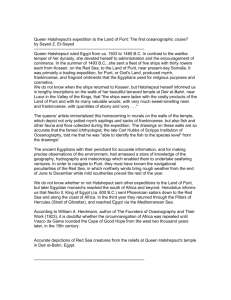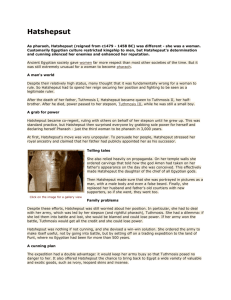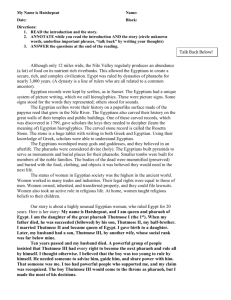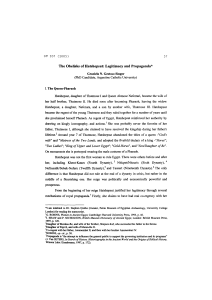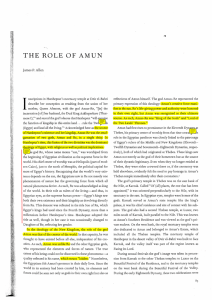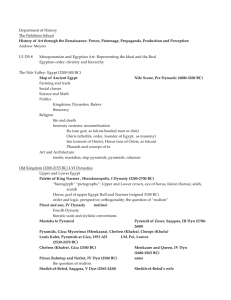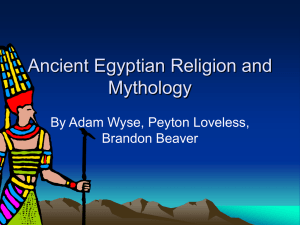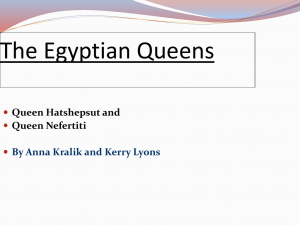Assessment Task Part B
advertisement
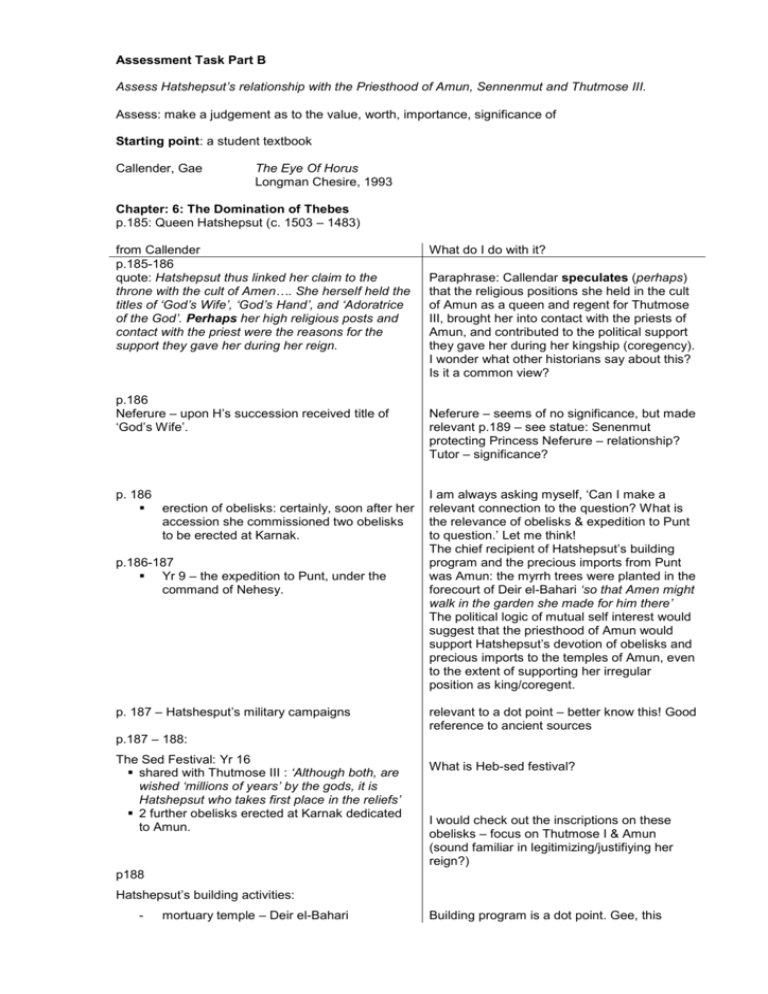
Assessment Task Part B Assess Hatshepsut’s relationship with the Priesthood of Amun, Sennenmut and Thutmose III. Assess: make a judgement as to the value, worth, importance, significance of Starting point: a student textbook Callender, Gae The Eye Of Horus Longman Chesire, 1993 Chapter: 6: The Domination of Thebes p.185: Queen Hatshepsut (c. 1503 – 1483) from Callender p.185-186 quote: Hatshepsut thus linked her claim to the throne with the cult of Amen…. She herself held the titles of ‘God’s Wife’, ‘God’s Hand’, and ‘Adoratrice of the God’. Perhaps her high religious posts and contact with the priest were the reasons for the support they gave her during her reign. p.186 Neferure – upon H’s succession received title of ‘God’s Wife’. p. 186 erection of obelisks: certainly, soon after her accession she commissioned two obelisks to be erected at Karnak. p.186-187 Yr 9 – the expedition to Punt, under the command of Nehesy. p. 187 – Hatshesput’s military campaigns What do I do with it? Paraphrase: Callendar speculates (perhaps) that the religious positions she held in the cult of Amun as a queen and regent for Thutmose III, brought her into contact with the priests of Amun, and contributed to the political support they gave her during her kingship (coregency). I wonder what other historians say about this? Is it a common view? Neferure – seems of no significance, but made relevant p.189 – see statue: Senenmut protecting Princess Neferure – relationship? Tutor – significance? I am always asking myself, ‘Can I make a relevant connection to the question? What is the relevance of obelisks & expedition to Punt to question.’ Let me think! The chief recipient of Hatshepsut’s building program and the precious imports from Punt was Amun: the myrrh trees were planted in the forecourt of Deir el-Bahari ‘so that Amen might walk in the garden she made for him there’ The political logic of mutual self interest would suggest that the priesthood of Amun would support Hatshepsut’s devotion of obelisks and precious imports to the temples of Amun, even to the extent of supporting her irregular position as king/coregent. relevant to a dot point – better know this! Good reference to ancient sources p.187 – 188: The Sed Festival: Yr 16 shared with Thutmose III : ‘Although both, are wished ‘millions of years’ by the gods, it is Hatshepsut who takes first place in the reliefs’ 2 further obelisks erected at Karnak dedicated to Amun. What is Heb-sed festival? I would check out the inscriptions on these obelisks – focus on Thutmose I & Amun (sound familiar in legitimizing/justifiying her reign?) p188 Hatshepsut’s building activities: - mortuary temple – Deir el-Bahari Building program is a dot point. Gee, this - - much work at Karnak: repairs to MK temple, Red Chapel, 4 obelisks, barque sanctuary, pylon (8) rock cut temple at Beni Hasan, dedicated to Pakhet, important for Speos Artemidos inscription - section would be a good starting point for my notes! Speos Artemidos inscription: Why does Callendar believe it to be so important? I would have notes from p189 What inscription contains: connect to variety of dot points p.189 Hatshepsut’s officials - - ‘The backbone of her administration lay in the powerful priesthood of Amun.’ Hapuseneb: high priest of Amun, involved in building of Deir el-Bahari, building program at Karnak plus: likely he was her vizier too Nehesy: leader of expedition to Punt, involved in construction of mortuary temple Now that’s a quote! Note the overlap of various areas of administration (religious & civil) ie priesthood of Amun not only restricted to temple administration. Vizier = pm – internal admin of Egypt – including judicial pp.189-190 Treasurer Senenmut - - - - Most famous of officials – tutor of Neferure Commoner Long list of roles / positions / titles during H’s reign: o Royal admin: treasurer / tutor of young Neferure; steward of property of H & N (at least to Yr 7); overseer of all the works of the king – supervised temple construction at Karnak o Religious admin: steward of god Amun Eminence & privileges – speculation of sexual relationship – Interesting issue: end ? fate? : statues, tomb vandalized: damnation – fallen into disgrace? Thutmose III, later Akhenaten? Hatshpesut herself? Dorman thinks unlikely 2nd tomb under forecourt of Deir el-Bahari – one assumes he had permission from H? never finished or occupied Death: Yr 18/19; or even in sole reign of Thutmose III What is Callender’s assessment? How important was he to Hatshepsut’s reign? What do other historians across time write? What attitude to Senenmut is conveyed by word choice of historians? Callendar believes unlikely - only evidence is graffito of uncertain date p. 190 Death and burial of Hatshepsut - - 21yrs 9 mths Died presumably of natural causes Tomb KV 20 – earliest constructed in KV – from Yr 7 (date of accession); directly behind mort. temple; Thut I buried there (moved later by Thut III) Mummy of Hatshepsut not identified Some time later: H’s name removed from monuments including Deir el Bahari (replaced by Thut I, II, III) – probably not until Yr 42 of Thut III’s reign: reason for this persecution is unknown - note importance of new discoveries: 2007 – Hawass – indentified H’s mummy (tooth!) - What was Thutmose III’s role & motivation in this? Thutmose III - 9 Yrs old on succession Oracle from Amun at Karnak legitimises reign: ie divine coronation - Coregency: played an active part in the government of Egypt o Yr 2 – issued orders to Viceroy of Kush o Yr 5 appointed a new vizier o Active in Sinai – graffiti – alone & with Hatshepsut (see p.192) o Led 2 military expeditions into Nubia, at least one campaign into Palestine (Gaza?) o Appears in H’s coronation scene o Inscriptions feature him as king without presence of Hatshepsut o Donations and buildings dedicated to gods ‘Thus there is a considerable body of material attesting to his active participation in government during his coregency with Hatshepsut’ Important to read beyond just Hatshepsut! Gives some good sources for assessing relationship during regency and coregency Callender’s view is clearly stated. How does this compare with other historians?
